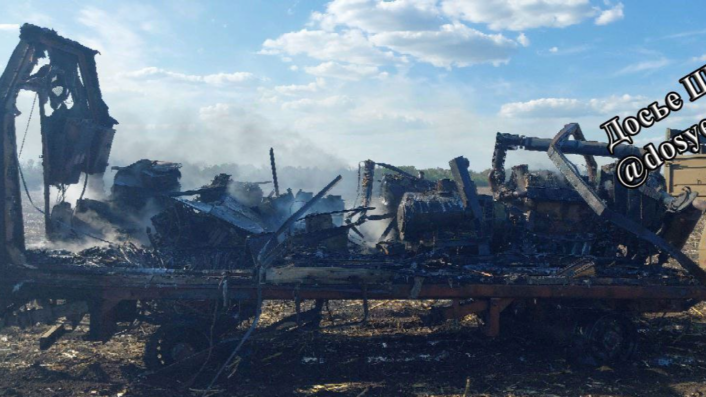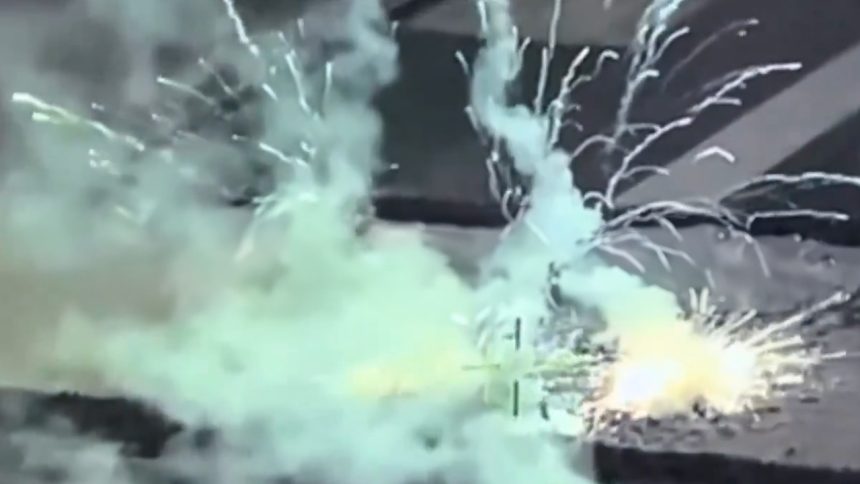Ukraine is using volleys of ATACMS missiles to destroy Russian S-400s.
Ukraine seems to have intensified its campaign to destroy the S-400 long-range air defense system before the arrival of the F-16s, and clear the air for the fighters. Again using the US-made ATACMS (Army Tactical Missile System) MGM-140B missile, it struck an S-400 battery at Mospyne, in Russian-occupied Donetsk on May 22-23, 2023. It destroyed the 96L6 radar and at least two of the launchers.
A video of the strike by an overhead drone shows the S-400 letting off six missiles from its tube launchers, before the field is covered by exploding bomblets, indicating the ATACMS missile has released its munitions. One of the launchers soon explodes in a massive blast, followed by another launcher being destroyed the same way.
#BREAKING Here’s the moment of Russian S-400 battery getting knocked off by Ukrainian ATACMS strikes in Mospyne, Donetsk region.
S-400s tried to shot down ATACMS missiles, but failed. https://t.co/MWY6OxBN2X pic.twitter.com/I7AoJGCMD3
— Clash Report (@clashreport) May 24, 2024
Bomblet-Dropping ATACMS is the Missile of Choice
Russia-affiliated handles themselves stated the tactic of Ukrainians “overloading” the S-400, where it tracks and engages multiple targets at a time, forcing it to release its missiles. The ATACMS, is then fired in coordination with what are possibly drones, is free of being intercepted by the S-400.
The specific ATACMS missile used could either be the M39 or the M39A1. Both are ‘Area Weapons Systems’, use GPS and GPS-aided inertial guidance and have maximum ranges of 165-km and 300-km respectively. Their primary feature is carrying M74 submunitions in their warhead, where the M39 carries 950 and the M39A1 holds 300 bomblets.
Given the physically delicate nature of the target involved, the choice of the missile seems to be accurate, as the bomblets spread out and manage hitting both the radar and the missile launchers. It would be pointless to use the precision point unitary warhead ATACMS variants like the M48 and the M57.

Tactics
A few known facts need to be looked at before we analyze how Ukraine is successfully striking the S-400. One, the system should ideally be deployed deep behind the frontlines and not ahead like the S-300, Buk, Tor or Pantsir long, medium and short-range AD systems. However, Mospyne is 40-km from the frontline, which leaves to wonder why the Russians brought the missile so close. Possibly, it could be to address the radar coverage gaps in that sector.
Secondly, the S-400 is capable of being operated in a fully autonomous mode, with no human intervention. There are signs that it was functioning in this mode when it was destroyed, as seen from the volley of missiles it was releasing. Defense Express Ukraine confirmed this, saying, “There are allegedly no losses in manpower.”
Destroyed Russian S-400 air defense battery in Mospyne, Donetsk region was deployed there only for a day when it was hit by Ukrainian ATACMS missiles. https://t.co/PNbskDxcXX pic.twitter.com/PwMKruZc5o
— Clash Report (@clashreport) May 24, 2024
This means Ukraine is possibly using volleys of ATACMS missiles itself to destroy the S-400, since regular HIMARS (High-Mobility Artillery Rocket System) rockets do not have the range to reach such deep distances behind the frontline.
Russia had successfully employed coordination between Buk-M3 and S-300 systems to shoot down several HIMARS rockets. Given that the S-400 is only used for large targets, it is unlikely it would fire such a volley on small drones that would be used for distraction. This is the best guess that could be drawn given the available facts.

Igor Sushko too said that the Ukrainian military used “5 ATACMS missiles” for the goal. It also needs to be taken into account that Russians have learnt to identify SEAD/DEAD (Suppression/Destruction of Enemy Air Defense) munitions like the ADM-160 MALD or the AGM-88 HARM (High-Speed Anti-Radiation Missile) and switch off their radar.
💥 Ukraine used 5 ATACMS missiles to destroy air defenses near Russia’s Mospyne airfield in occupied Donetsk region at ~12:50pm May 22 2024.
– Two S-300/400 SAM launchers destroyed, one damaged.
– 96L6E radar system destroyed.
– Control center for S-300/400 systems destroyed. pic.twitter.com/W5QlmiAMOw
— Igor Sushko (@igorsushko) May 23, 2024
Thus in conclusion, while Russia is losing S-400s, Ukraine too is rapidly burning through its stock of ATACMS, which are only destroying tactical targets like air defense placements. What Ukraine needs to hit are bigger land targets like fortified defensive positions, battlefield headquarters and large logistics supply nodes in Russia’s rear. Possibly, it is calculated that such targets are better left for the F-16s.
Last ATACMS Strike on S-400
The last such attack on a Russian air defense site took place in the wee hours of May 15, 2024. At the time, Ukraine released the same MGM-140B ATACMS to hit an S-400 at the Belbek air base in Crimea.
Kremlin-aligned defense analysis forum Rybar said on its Telegram channel that the “AFU launched a new strike on Crimean airfields.” “This time Belbek was targeted and up to 16 ATACMS tactical missiles with cluster warheads were fired at it.” On its Telegram channel, Rybar said Ukraine used “both drones and ballistic missiles,” where judging by the tactics, the “first wave” of UAVs was used for “distraction.”
UAVs were detected at the Round Bay of Sevastopol, one shot down over Simferopol and several drones detect “west of Belbek.” These were possibly not for strikes but for “target designation and missile guidance.” The AFU then launched “several ATACMS missiles” from the Yavkino area in the Nikolaev region. RuMoD on May 16 claimed that seven US-made ATACMS were shot down, which could possibly involve some of those fired at Belbek.









